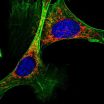(Press-News.org) Chronic pain in humans is associated with worse health and a shorter lifespan, but the molecular mechanisms underlying these clinical observations have not been clear. A study published by Cell Press May 22nd in the journal Cell reveals that the activity of a pain receptor called TRPV1 regulates lifespan and metabolic health in mice. The study suggests that pain perception can affect the aging process and reveals novel strategies that could improve metabolic health and longevity in humans.
"The TRPV1 receptor is a major drug target with many known drugs in the clinic that can affect its function," says senior study author Andrew Dillin of the University of California, Berkeley. "Finding that manipulation of this receptor can not only promote a youthful metabolism but also increase lifespan should be highly significant for age-related maladies, diabetes being a major one."
Past research has shown that mice lacking TRPV1 are protected against diet-induced obesity, suggesting that this receptor plays a role in metabolism. Intriguingly, diets rich in capsaicin—the active molecule of chili peppers that can overstimulate and kill TRPV1 neurons—have long been linked to lower incidents of diabetes and metabolic problems in humans. Moreover, disruption of sensory perception increases longevity in worms and flies. But until now, it was not known whether sensory perception also affects aging in mammals.
Addressing this question in the new study, Dillin and his team found that mice genetically manipulated to lack TRPV1 receptors lived on average nearly four months, or about 14%, longer than normal mice. The TRPV1-deficient mice also showed signs of a youthful metabolism late in life, due to low levels of calcitonin gene-related peptide (CGRP)—a molecule that increases blood glucose levels and thus could contribute to the development of type 2 diabetes. Throughout aging, these mice showed improved glucose tolerance—the ability to quickly clear sugar from the blood—as well as signs that they could burn more calories without exercising more than normal.
Moreover, old mice treated with a compound that inhibits the activity of CGRP receptors showed a more youthful metabolic profile than untreated old mice. "Our findings suggest that pharmacological manipulation of TRPV1 and CGRP may improve metabolic health and longevity," Dillin says. "Alternatively, chronic ingestion of compounds that affect TRPV1 such as capsaicin might help prevent metabolic decline with age and lead to increased longevity in humans."
INFORMATION:
Cell, Riera et al.: "TRPV1 Pain Receptors Regulate Longevity and Metabolism by Neuropeptide Signaling."
Blocking pain receptors found to extend lifespan in mammals
2014-05-22
ELSE PRESS RELEASES FROM THIS DATE:
Genes discovered linking circadian clock with eating schedule
2014-05-22
LA JOLLA—For most people, the urge to eat a meal or snack comes at a few, predictable times during the waking part of the day. But for those with a rare syndrome, hunger comes at unwanted hours, interrupts sleep and causes overeating.
Now, Salk scientists have discovered a pair of genes that normally keeps eating schedules in sync with daily sleep rhythms, and, when mutated, may play a role in so-called night eating syndrome. In mice with mutations in one of the genes, eating patterns are shifted, leading to unusual mealtimes and weight gain. The results were published ...
New technology may help identify safe alternatives to BPA
2014-05-22
Numerous studies have linked exposure to bisphenol A (BPA) in plastic, receipt paper, toys, and other products with various health problems from poor growth to cancer, and the FDA has been supporting efforts to find and use alternatives. But are these alternatives safer? Researchers reporting in the Cell Press journal Chemistry & Biology have developed new tests that can classify such compounds' activity with great detail and speed. The advance could offer a fast and cost-effective way to identify safe replacements for BPA.
Millions of tons of BPA and related compounds ...
Discovery of how Taxol works could lead to better anticancer drugs
2014-05-22
VIDEO:
This video shows how the constant addition of tubulin bound to GTP provides a cap that prevents the microtubule from falling apart. UC Berkeley scientists found that the hydrolyzation of...
Click here for more information.
University of California, Berkeley, scientists have discovered the extremely subtle effect that the prescription drug Taxol has inside cells that makes it one of the most widely used anticancer agents in the world.
The details, involving the drug's ...
Gene behind unhealthy adipose tissue identified
2014-05-22
Researchers at Karolinska Institutet in Sweden have for the first time identified a gene driving the development of pernicious adipose tissue in humans. The findings imply, which are published in the scientific journal Cell Metabolism, that the gene may constitute a risk factor promoting the development of insulin resistance and type 2 diabetes.
Adipose tissue can expand in two ways: by increasing the size and/or the number of the fat cells. It is well established that subjects with few but large fat cells, so-called hypertrophy, display an increased risk of developing ...
Computer models helping unravel the science of life?
2014-05-22
Scientists have developed a sophisticated computer modelling simulation to explore how cells of the fruit fly react to changes in the environment.
The research, published today in the science journal Cell, is part of an on-going study at The Universities of Manchester and Sheffield that is investigating how external environmental factors impact on health and disease.
The model shows how cells of the fruit fly communicate with each other during its development. Dr Martin Baron, who led the research, said: "The work is a really nice example of researchers from different ...
Supportive tissue in tumors hinders, rather than helps, pancreatic cancer
2014-05-22
HOUSTON – Fibrous tissue long suspected of making pancreatic cancer worse actually supports an immune attack that slows tumor progression but cannot overcome it, scientists at The University of Texas MD Anderson Cancer Center report in the journal Cancer Cell.
"This supportive tissue that's abundant in pancreatic cancer tumors is not a traitor as we thought but rather an ally that is fighting to the end. It's a losing battle with cancer cells, but progression is much faster without their constant resistance," said study senior author Raghu Kalluri, Ph.D., M.D., chair ...
Blocking pain receptors extends lifespan, boosts metabolism in mice
2014-05-22
Blocking a pain receptor in mice not only extends their lifespan, it also gives them a more youthful metabolism, including an improved insulin response that allows them to deal better with high blood sugar.
"We think that blocking this pain receptor and pathway could be very, very useful not only for relieving pain, but for improving lifespan and metabolic health, and in particular for treating diabetes and obesity in humans," said Andrew Dillin, a professor of molecular and cell biology at the University of California, Berkeley, and senior author of a new paper describing ...
One molecule to block both pain and itch
2014-05-22
Duke University researchers have found an antibody that simultaneously blocks the sensations of pain and itching in studies with mice.
The new antibody works by targeting the voltage-sensitive sodium channels in the cell membrane of neurons. The results appear online on May 22 in Cell.
Voltage-sensitive sodium channels control the flow of sodium ions through the neuron's membrane. These channels open and close by responding to the electric current or action potential of the cells. One particular type of sodium channel, called the Nav1.7 subtype, is responsible for ...
Deciphered the process through which cells optimize metabolism to burn sugars or fats
2014-05-22
To guarantee efficient use of nutrients, cells have systems that permit them to capture and transport the available nutrient molecules to their interior. But if several nutrients are available, cells can select those that are of most interest and discard undesired molecules.
Inside cells, nutrients are conducted to the mitochondria, the specialized cell organelles in which nutrients are combusted to release the energy held in their chemical bonds. Both sugars (glucose) and fats (fatty acids) are 'burned' in mitochondria, but these organelles need to adjust their molecular ...
New insight into stem cell development
2014-05-22
The world has great expectations that stem cell research one day will revolutionize medicine. But in order to exploit the potential of stem cells, we need to understand how their development is regulated. Now researchers from University of Southern Denmark offer new insight.
Stem cells are cells that are able to develop into different specialized cell types with specific functions in the body. In adult humans these cells play an important role in tissue regeneration. The potential to act as repair cells can be exploited for disease control of e.g. Parkinson's or diabetes, ...




